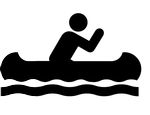 On a hot summer day in late August, you paddle down one of the many waterways encompassed in the St. Regis Lake Canoe Area, not far from Paul Smith’s College. The paddle is peaceful and quiet. As you continue down the water, you notice that some of the ponds are surrounded by large, expensive houses, while others present a scenery so undisturbed by human intervention that the students forget the existence of nearby busy cities and towns. Your Kevlar canoe is lightweight, yet extremely agile, inspired by the old guideboats of the early 19th century. Being completely enclosed by trees, in the middle of a lake, trapped in nature, this landscape feels inherently different. This land is Forever Wild.
On a hot summer day in late August, you paddle down one of the many waterways encompassed in the St. Regis Lake Canoe Area, not far from Paul Smith’s College. The paddle is peaceful and quiet. As you continue down the water, you notice that some of the ponds are surrounded by large, expensive houses, while others present a scenery so undisturbed by human intervention that the students forget the existence of nearby busy cities and towns. Your Kevlar canoe is lightweight, yet extremely agile, inspired by the old guideboats of the early 19th century. Being completely enclosed by trees, in the middle of a lake, trapped in nature, this landscape feels inherently different. This land is Forever Wild.
Through our research presented on this website, we will focus on ecotourism and its associated economic, ecological, and governmental impacts on the Adirondacks. We will be presenting this information through a specific case study on flat-water paddling. Of the entire Adirondack Park landscape, 6.4% of the 5.9 million acres is water, which presents fantastic paddling opportunities for tourists (Jenkins, 25). From an ecological perspective, canoeing can have detrimental effects, particularly on a region such as the St. Regis Lake Canoe Area, due to the large number of bodies of water in a condensed area. However, from an economic perspective, there are great benefits to flat-water paddling. Throughout our website, we will examine the positive and more difficult aspects of the flat-water paddling industry in the Adirondack Park, paying special attention to the broad range of effects that this form of ecotourism has on the park’s natural landscape, and those who reside within the Blue Line.
_______________________________________________________________________________________________________
Works Cited:

